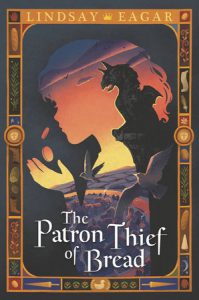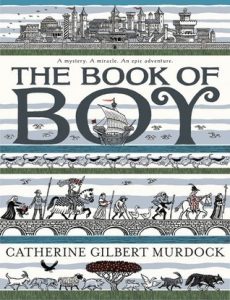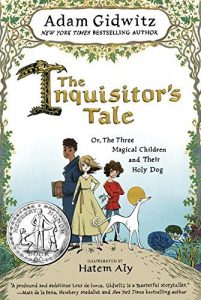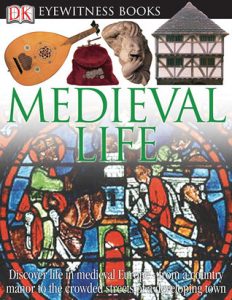By Holly Johnson, Professor Emerita, University of Cincinnati, Cincinnati, OH
 Creating a love of history in many young people often feels like a Sisyphean effort with some time periods garnering more attention than others. I personally love the history of the American West, so it came as a big surprise that several of my favorite books for young people focus on Europe’s Middle Ages. With such wonderful literature available, a spark could be lit and young people’s imaginations could take flight.
Creating a love of history in many young people often feels like a Sisyphean effort with some time periods garnering more attention than others. I personally love the history of the American West, so it came as a big surprise that several of my favorite books for young people focus on Europe’s Middle Ages. With such wonderful literature available, a spark could be lit and young people’s imaginations could take flight.
One of my current favorite books is The Patron Thief of Bread (2022) by Lindsay Eagar. A baby is fished from a river by a boy who is part of a band of street urchins. They are the Crowns and soon that baby grows into a girl named Duck, named as such because of her river rescue. Duck is eight and the youngest of the group. She is also targeted by the Crown’s leader Gnat, who decides that Duck must become a baker’s apprentice so she can steal bread and money for the group. A problem arises when Duck becomes attached to both the bakery and the baker.
Duck is faced with the dilemma in which she must decide where her loyalty lies. If she remains with the Crowns, she must continue to steal from Griselde, the baker, but if she determines she is safer and happier with Griselde, then the Crowns lose a food source and Duck loses her family.
Gnat decides to force Duck’s decision, which creates changes in the dynamics of the Crowns, and with those changes, there is an opportunity that could improve life for the Crowns and for Duck, but that opportunity comes with a cost. They must decide if the improvements to their material circumstances are worth the risk of betraying the family and only life they’ve known.
 The Patron Thief of Bread is a beautiful story about love, loyalty, family, and how the past creates the present. Duck is a bright and shining character that displays the courage and strength to overcome adversity by which, she discovers an ever-expanding sense of love.
The Patron Thief of Bread is a beautiful story about love, loyalty, family, and how the past creates the present. Duck is a bright and shining character that displays the courage and strength to overcome adversity by which, she discovers an ever-expanding sense of love.
Alternately, The Book of Boy (2018) by Catherine Gilbert Murdock is a wondrous book that deserves special attention. A boy in a tree in love with the feeling of flight is “conscripted” into the service of a pilgrim who is collecting ancient religious relics. From there, the adventure begins and readers of Boy’s story will fall in love with not only the character himself, but also his desire for knowing and hope for his future.
 The Inquisitor’s Tale or The Three Magical Children and Their Holy Dog by Adam Gidwitz and illustrated by Hatem Aly (2018) is another magical book for young readers. A tale told in a medieval inn allows several of those at the inn to contribute to the story of a peasant girl, a young monk, and a Jewish boy who band together and through their conjoined lives address ignorance and prejudice and injustice. It is a marvelous read!
The Inquisitor’s Tale or The Three Magical Children and Their Holy Dog by Adam Gidwitz and illustrated by Hatem Aly (2018) is another magical book for young readers. A tale told in a medieval inn allows several of those at the inn to contribute to the story of a peasant girl, a young monk, and a Jewish boy who band together and through their conjoined lives address ignorance and prejudice and injustice. It is a marvelous read!
 Each and every one of these books can stand on its own. Yet the context of the stories, and the plight of children in the Middle Ages can give younger readers a greater understanding of how precarious life was and, perhaps, still is for young people. Especially those who are different or on their own. In addition, there are several informational books that add to young readers’ understandings of the time period between 100—1400. Books such as Kathryn Hinds’ Life in the Middle Ages series or Daniele Cybulskie’s (2021) Life in Medieval Europe: Fact and Fiction can add contextual information that fleshes out Duck’s story and gives insight into the lives of people within villages and towns. DK’s Eyewitness book (2011) entitled, Medieval Life: Discover Medieval Europe from Life in a Country Manor to the Streets of a Growing Town is a visual feast of photos and drawings that can expand readers’ sense of the material life of the Middle Ages.
Each and every one of these books can stand on its own. Yet the context of the stories, and the plight of children in the Middle Ages can give younger readers a greater understanding of how precarious life was and, perhaps, still is for young people. Especially those who are different or on their own. In addition, there are several informational books that add to young readers’ understandings of the time period between 100—1400. Books such as Kathryn Hinds’ Life in the Middle Ages series or Daniele Cybulskie’s (2021) Life in Medieval Europe: Fact and Fiction can add contextual information that fleshes out Duck’s story and gives insight into the lives of people within villages and towns. DK’s Eyewitness book (2011) entitled, Medieval Life: Discover Medieval Europe from Life in a Country Manor to the Streets of a Growing Town is a visual feast of photos and drawings that can expand readers’ sense of the material life of the Middle Ages.
Together this text set of books can fill a the void of an historical time period often underappreciated and misunderstood.
WOW Currents is a space to talk about forward-thinking trends in global children’s and adolescent literature and how we use that literature with students. “Currents” is a play on words for trends and timeliness and the way we talk about social media. We encourage you to participate by leaving comments and sharing this post with your peers. To view our complete offerings of WOW Currents, please visit its archival stream.
- Themes: Adam Gidwitz, Book of Boy, Catherine Gilbert Murdock, Daniele Cybulskie, Hatem Aly, Holly Johnson, Inquisitor's Tale or The Three Magical Children and Their Holy Dog, Kathryn Hinds, Life in Midieval Europe: Fact and Fiction, Life in the Middle Ages, Lindsay Eagar, Patron Thief of Bread
- Descriptors: Books & Resources, WOW Currents
